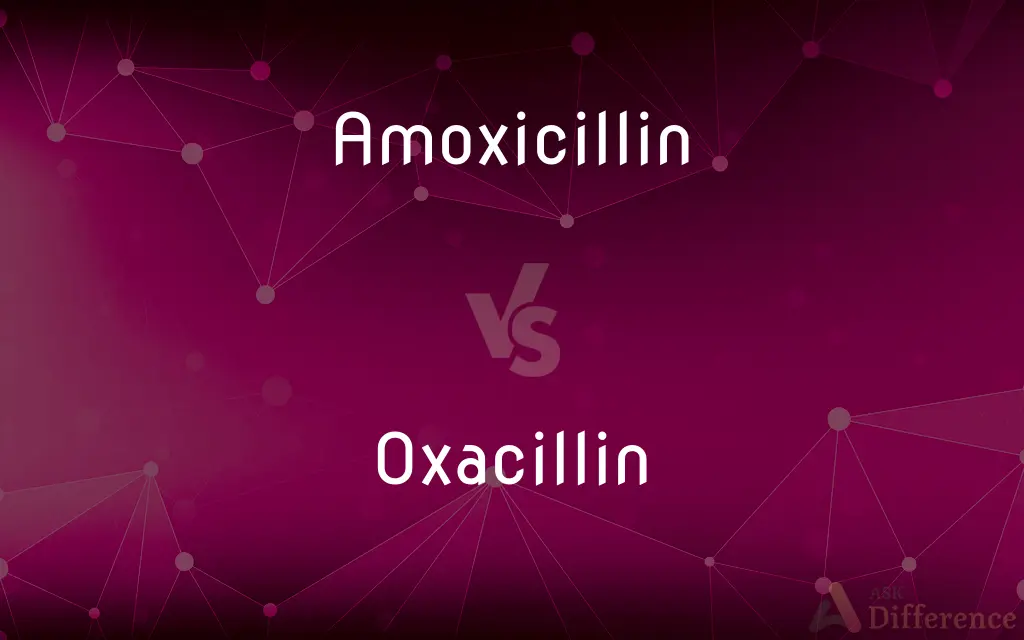Amoxicillin vs. Oxacillin — What's the Difference?
By Tayyaba Rehman & Fiza Rafique — Updated on March 24, 2024
Amoxicillin is a broad-spectrum antibiotic used to treat various bacterial infections, known for its oral effectiveness. Oxacillin, narrower in scope, targets penicillin-resistant bacteria and is typically administered intravenously.

Difference Between Amoxicillin and Oxacillin
Table of Contents
ADVERTISEMENT
Key Differences
Amoxicillin is part of the penicillin antibiotic family, effective against a wide range of bacterial infections including ear, throat, and urinary tract infections. Whereas oxacillin is designed to combat penicillinase-producing bacteria, making it a choice for treating certain staph infections.
While amoxicillin is commonly prescribed for a variety of infections due to its broad-spectrum nature and is generally taken orally, oxacillin's use is more specific, often reserved for hospital settings to treat severe infections via intravenous administration.
Amoxicillin's broad-spectrum efficacy means it can impact a wide variety of bacteria, potentially leading to a higher risk of antibiotic resistance if overused. On the other hand, oxacillin's narrower target range helps limit its use to specific bacteria, potentially reducing the risk of developing resistance.
Amoxicillin is known for its good absorption from the gastrointestinal tract, making it effective as an oral medication. In contrast, oxacillin's properties necessitate intravenous administration to ensure adequate levels reach the site of infection.
Due to its broad-spectrum nature, amoxicillin may sometimes cause a wider range of side effects, including gastrointestinal discomfort. Oxacillin, while potent, may have more specific side effects related to its intravenous administration and its action on certain bacteria.
ADVERTISEMENT
Comparison Chart
Spectrum
Broad-spectrum, effective against various bacteria
Narrow-spectrum, targets penicillin-resistant bacteria
Administration
Oral
Primarily intravenous
Common Use
Ear, throat, urinary tract infections
Specific staph infections
Absorption
Good oral absorption
Requires IV for effective delivery
Risk of Resistance
Higher due to broad-spectrum action
Lower, used for specific bacteria
Compare with Definitions
Amoxicillin
A broad-spectrum antibiotic used to treat a variety of infections.
Amoxicillin is often prescribed for children's ear infections.
Oxacillin
A narrow-spectrum antibiotic targeting penicillin-resistant bacteria.
Oxacillin was administered to treat his staph infection.
Amoxicillin
Can lead to antibiotic resistance if overused.
Incorrect use of amoxicillin might contribute to antibiotic resistance.
Oxacillin
Used for specific infections, often in a hospital setting.
Oxacillin is used intravenously for severe infections.
Amoxicillin
May cause gastrointestinal side effects.
Taking amoxicillin can sometimes result in stomach upset.
Oxacillin
Requires intravenous administration due to its properties.
The nurse prepared an oxacillin IV for the patient.
Amoxicillin
Known for oral effectiveness and gastrointestinal absorption.
Amoxicillin capsules need to be taken with water.
Oxacillin
Side effects may relate to intravenous administration.
Local irritation at the IV site is a possible side effect of oxacillin.
Amoxicillin
Part of the penicillin class, effective against many bacteria.
She was given amoxicillin for her throat infection.
Oxacillin
Lower risk of contributing to widespread antibiotic resistance.
Oxacillin's targeted use helps minimize resistance issues.
Amoxicillin
Amoxicillin is an antibiotic used to treat a number of bacterial infections. These include middle ear infection, strep throat, pneumonia, skin infections, and urinary tract infections among others.
Oxacillin
Oxacillin (trade name Bactocill) is a narrow-spectrum beta-lactam antibiotic of the penicillin class developed by Beecham.It was patented in 1960 and approved for medical use in 1962.
Amoxicillin
A semisynthetic penicillin, C16H19N3O5S, having an antibacterial spectrum of action similar to that of ampicillin.
Oxacillin
A semisynthetic penicillin, C19H19N3O5S, that is resistant to penicillinase, used in the form of its sodium salt primarily to treat infections caused by penicillinase-producing staphylococcus bacteria.
Amoxicillin
(pharmaceutical drug) A moderate-spectrum, bacteriolytic beta-lactam antibiotic C16H19N3O5S closely related to ampicillin and with similar properties, but more readily absorbed when taken orally. It is used to treat bacterial infections caused by susceptible microorganisms.
Oxacillin
(pharmaceutical drug) A narrow-spectrum beta-lactam antibiotic made by chemical modification of penicillin and administered in the form of its hydrated sodium salt C19H18N3NaO5S·H2O to treat infections caused by penicillin-resistant staphylococci.
Amoxicillin
An antibiotic; a semisynthetic oral penicillin (trade names Amoxil and Larotid and Polymox and Trimox and Augmentin) used to treat bacterial infections
Oxacillin
A form of penicillin resistant to penicillinase and effective against penicillin-resistant staphylococci
Common Curiosities
Why is oxacillin administered intravenously?
Oxacillin is typically administered intravenously to ensure adequate drug levels reach the site of infection, as its properties may not allow for effective oral absorption.
Is antibiotic resistance a concern with amoxicillin?
Yes, the overuse or incorrect use of amoxicillin, like other antibiotics, can contribute to the development of antibiotic-resistant bacteria.
Can I switch from amoxicillin to oxacillin if the former is not effective?
Any change in antibiotics should be based on medical advice, often after testing to identify the most effective antibiotic for the specific infection.
Can amoxicillin be used for any infection?
While amoxicillin is broad-spectrum, it's not suitable for all infections, particularly those caused by resistant bacteria or non-bacterial pathogens.
Why might a doctor prescribe amoxicillin over oxacillin?
A doctor might choose amoxicillin for its broad-spectrum efficacy, especially if the exact nature of the bacteria is unknown or if it's known to be effective against the suspected bacteria.
What is amoxicillin used for?
Amoxicillin is used to treat a wide range of bacterial infections, including ear, throat, and urinary tract infections.
What makes oxacillin different from other penicillins?
Oxacillin is designed to combat penicillinase-producing, penicillin-resistant bacteria, making it effective against certain staph infections.
What should I do if I experience side effects from these antibiotics?
Report any side effects to your healthcare provider, who can advise on the best course of action, which may include adjusting the dosage or switching medications.
Can I drink alcohol while taking these antibiotics?
Alcohol can interfere with the effectiveness of antibiotics and increase the risk of side effects. It's best to avoid alcohol while taking any antibiotic.
Are there any specific side effects associated with oxacillin?
Side effects of oxacillin may include those common to intravenous administration, such as irritation at the injection site, as well as any reactions specific to its antibacterial action.
How are dosages determined for these antibiotics?
Dosages are based on the type and severity of the infection, the patient's age, weight, and kidney function, among other factors.
What is the mechanism of action of these antibiotics?
Both amoxicillin and oxacillin work by inhibiting the synthesis of bacterial cell walls, leading to the death of the bacteria.
Can I use amoxicillin or oxacillin for a viral infection?
No, antibiotics like amoxicillin and oxacillin are ineffective against viruses and should not be used for viral infections.
How long does it take for these antibiotics to work?
While some symptoms might improve within a few days, it's important to complete the full course of antibiotics as prescribed to fully eradicate the infection.
Are there any foods or drugs I should avoid while taking amoxicillin or oxacillin?
Certain foods and drugs can interact with antibiotics, so it's important to discuss your current medications and diet with your healthcare provider.
Share Your Discovery

Previous Comparison
Flowstone vs. Dripstone
Next Comparison
Tylenol vs. EquateAuthor Spotlight
Written by
Tayyaba RehmanTayyaba Rehman is a distinguished writer, currently serving as a primary contributor to askdifference.com. As a researcher in semantics and etymology, Tayyaba's passion for the complexity of languages and their distinctions has found a perfect home on the platform. Tayyaba delves into the intricacies of language, distinguishing between commonly confused words and phrases, thereby providing clarity for readers worldwide.
Co-written by
Fiza RafiqueFiza Rafique is a skilled content writer at AskDifference.com, where she meticulously refines and enhances written pieces. Drawing from her vast editorial expertise, Fiza ensures clarity, accuracy, and precision in every article. Passionate about language, she continually seeks to elevate the quality of content for readers worldwide.














































